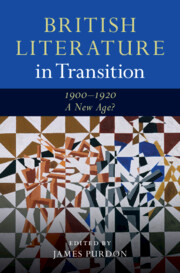Book contents
- British Literature in Transition, 1900–1920: A New Age?
- British Literature in Transition Series
- British Literature in Transition, 1900–1920: A New Age?
- Copyright page
- Contents
- Contributors
- General Editor’s Preface
- Acknowledgements
- Introduction
- Part I Nation and Empire
- Part II Media
- Chapter 7 Literature and Wartime Propaganda
- Chapter 8 Black, White, and Read All Over
- Chapter 9 Notable Trials and Literary Realism
- Chapter 10 Literature and Telecommunication
- Chapter 11 Literature and Film
- Part III Aesthetics
- Part IV Society
- Index
Chapter 9 - Notable Trials and Literary Realism
from Part II - Media
Published online by Cambridge University Press: 07 December 2021
- British Literature in Transition, 1900–1920: A New Age?
- British Literature in Transition Series
- British Literature in Transition, 1900–1920: A New Age?
- Copyright page
- Contents
- Contributors
- General Editor’s Preface
- Acknowledgements
- Introduction
- Part I Nation and Empire
- Part II Media
- Chapter 7 Literature and Wartime Propaganda
- Chapter 8 Black, White, and Read All Over
- Chapter 9 Notable Trials and Literary Realism
- Chapter 10 Literature and Telecommunication
- Chapter 11 Literature and Film
- Part III Aesthetics
- Part IV Society
- Index
Summary
In 1906, under the guiding editorial hand of William Roughead, a new series of books appeared under the title Notable Trials. These tremendously popular volumes capitalised on a burgeoning fascination with the criminal trial and a focus upon the courtroom, in place of the scaffold, as the ultimate symbol of the justice system. While many of the early volumes dealt with historically significant trials, by 1920 attention was very much directed towards what would dominate the series as it developed in the ensuing decades until its demise in the 1950s: namely, the contemporary trial marked by some element of personal interest. The Notable Trials are an early example of what would now be called ‘true crime’: a form which trades on reality as cachet. Yet the series also tended to publish accounts of trials in which the verdict was in some way doubtful. This chapter argues that the conceptualisation of realist narrative as potentially faulty, which underpinned the success of Notable Trials, also shaped the development of literature in the period, and in particular the various forms of doubt and uncertainty which characterise the fiction of literary impressionism.
- Type
- Chapter
- Information
- British Literature in Transition, 1900–1920: A New Age? , pp. 177 - 191Publisher: Cambridge University PressPrint publication year: 2021

